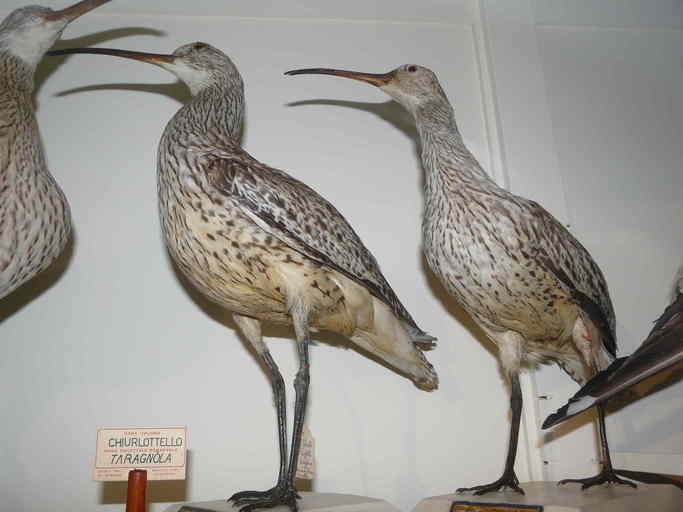Slender-billed Curlew
A species of Curlews Scientific name : Numenius tenuirostris Genus : Curlews
Slender-billed Curlew, A species of Curlews
Botanical name: Numenius tenuirostris
Genus: Curlews
Content
Description General Info
Description
The slender-billed curlew is a small curlew, 36–41 cm in length with a 77–88 cm wingspan. It is therefore about the same size as a Eurasian whimbrel, but it is more like the Eurasian curlew in plumage. The breeding adult is mainly greyish brown above, with a whitish rump and lower back. The underparts are whitish, heavily streaked with dark brown. The flanks have round or heart-shaped spots. The non-breeding plumage is similar, but with fewer flank spots. Male and female are alike in plumage, but females are longer-billed than males, an adaptation in curlew species that eliminates direct competition for food between the sexes. The juvenile plumage is very similar to the adult, but the flank are marked with brown streaking, the heart-shaped spots only appearing toward the end of the first winter. Compared to the Eurasian curlew, the slender-billed curlew is whiter on the breast, tail, and underwing, and the bill is shorter, more slender, and slightly straighter at the base. The arrowhead-shaped flank spots of the Eurasian curlew also are different from the round or heart-shaped spots of the slender-billed. The head pattern, with a dark cap and whitish supercilium, recalls that of the whimbrel, but that species also has a central crown stripe and a more clearly marked pattern overall; the pattern of the slender-billed curlew would be hard to make out in the field. This species shows more white than other curlews, and the white underwings, along with the distinctive flank markings, are key identification criteria. 
Size
41 cm
General Info
Behavior
Little is known about the breeding biology, but on average the few nests observed had four eggs. Slender-billed curlews feed by using their bills to probe soft mud for small invertebrates, but will also pick other small items off the surface if the opportunity arises. It used to be highly gregarious outside the breeding season, associating with related species, particularly Eurasian curlews. 
Species Status
After a long period of steady decline, the slender-billed curlew is extremely rare, with only a minute and still declining population. This is thought to be fewer than 50 adult birds, with the last verified sighting in 2004. As a result, it is now listed as critically endangered. The primary cause of the decline is thought to be excessive hunting on the Mediterranean wintering grounds. Habitat loss, particularly in the wintering grounds, may also have played a part, but huge areas of forest bogs suitable for breeding still exist in Siberia. It is unknown to what extent the birds still reproduce successfully, and how much gene flow still exists in what may once have been a large and widely dispersed population undergoing little purging of deleterious recessive alleles and consequently with a high MVP. Furthermore, there is evidence that birds in winter quarters were more numerous once, and in general not a very rare sight in Western Europe in the nineteenth century, where they were hunted with some regularity. Later on they were additionally threatened by pollution, e.g. oil spills. There are no data about how these threats endanger the species today. Theoretically, they might have retreated to all but inaccessible areas, but then, a single hunter or fox might unwittingly wipe out enough of the few remaining birds to doom the species. The last well-documented nest was found in 1924, near Tara in Omsk oblast, Siberia (57°N 74°E / 57°N 74°E / 57; 74). Its nesting grounds since then remain unknown, despite several intensive searches (not surprising, with more than 100,000 square kilometres to search). The extent of its decline also is reflected in the absence of wintering birds at previously regular Moroccan sites. More recently, 20 birds were recorded in Italy in 1995. There was a potential record of an immature (one year old) at Druridge Pools in Northumberland, England, on 4–7 May 1998, for details of which see the Druridge Bay curlew. The bird was initially accepted onto the British List but was removed in 2013 following a review of the identification. Slender-billed curlews have been reported in various Western Palearctic locations on a number of occasions since the Druridge bird, including claimed, but unverified, sightings of single birds from Italy and Greece; none have been documented with conclusive photographs and at least one claimed bird, at RSPB Minsmere, Suffolk, England, in 2004, is now widely believed to have been a Eurasian curlew. Further sourced reports of the species were published in 2007, in British Birds magazine; the article stated, quoting from Zhmud: During the last few years, small groups of birds have been found in the northern coastal areas [of the Danube Delta], frequenting low-lying islands, bays, and sand-spits covered with Common Glasswort Salicornia europaea [...] Four birds were present from 25th July to 21st August 2003, six were seen on 11th August 2004, and another on 12th August 2004. A sighting of a single bird was reported from Albania in 2006 by a team including ornithologists from the environmental organization EuroNatur. Thus, although hard proof is lacking, but given the extent of possible habitat and the precautionary principle, it is believed to be extant for the time being. Apparently at least the wintering range has starkly contracted; it appears that the handful of family or neighbour groups that are left retreat to remote habitat in southeastern Europe in winter. The IUCN classifies it as Critically Endangered (CR) C2a(ii); D. This means that an estimated 50 mature birds or fewer are believed to exist, with numbers declining, and that there probably is only one subpopulation. 
Scientific Classification
Phylum
Chordates Class
Birds Order
Shorebirds Family
Sandpipers Genus
Curlews Species
Slender-billed Curlew 